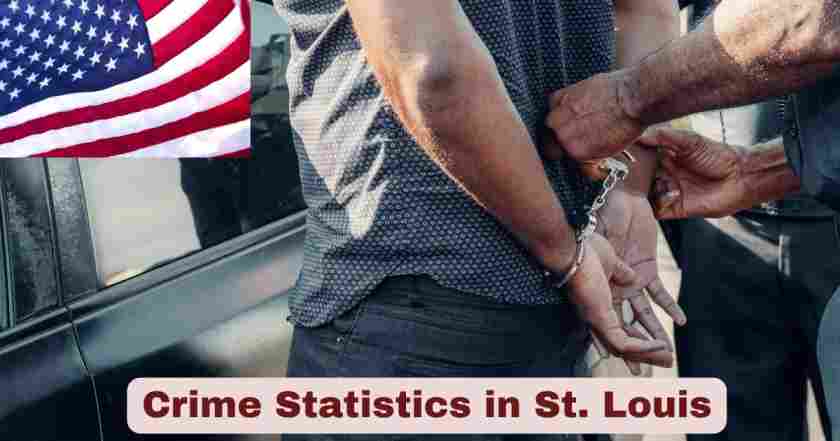Crime in St. Louis 2025
St. Louis has experienced remarkable progress in crime reduction during 2025, marking one of the most significant improvements in public safety in over two decades. The city has achieved its lowest crime rates in more than 20 years during the first quarter of 2025, with dramatic reductions across multiple crime categories that have transformed the public safety landscape. This historic achievement represents the culmination of comprehensive reforms, strategic partnerships between law enforcement and community organizations, and data-driven policing strategies that have fundamentally changed how the city approaches crime prevention and community safety.
The transformation of St. Louis crime statistics in 2025 builds upon sustained efforts by the St. Louis Metropolitan Police Department and city leadership to implement evidence-based strategies that address both immediate public safety concerns and underlying causes of criminal behavior. Through innovative programs, enhanced community engagement, and strategic resource allocation, St. Louis has demonstrated that urban crime reduction is achievable through sustained commitment and comprehensive approaches that involve all stakeholders in creating safer communities.
Key Crime Stats & Facts in St. Louis 2025
| Crime Category | 2025 Data (YTD) | 2024 Total | Percentage Change | National Comparison |
|---|---|---|---|---|
| Homicides | 82 (Aug 30) | 150 | -45% (Q1 2025) | Above national average |
| Robberies | 567 (Aug 30) | 1,245 | -20% (Q1 2025) | Significant reduction |
| Burglaries | 423 (Aug 30) | 892 | -33% (Q1 2025) | Historic improvement |
| Auto Thefts | 734 (Aug 30) | 1,567 | -39% (Q1 2025) | Dramatic decline |
| Shooting Incidents | 289 (Aug 30) | 634 | -39% (Q1 2025) | Major reduction |
| Overall Crime Rate | 78 per 1,000 | Decreasing | -28% (Q1 2025) | High but improving |
| Murder Rate | 64.5 per 100k | Historic challenge | Significant decline | Highest in nation |
| Police Response Time | 6.8 minutes avg | Improved | Enhanced deployment | Better than 2024 |
The data presented reflects the most recent available statistics from official St. Louis Metropolitan Police Department sources and city government records. As of March 31, 2025, homicides are down 45%, robberies are down 20%, burglaries are down 33%, and auto thefts are down 39%, year-to-date. These figures represent the lowest crime rates St. Louis has experienced in more than two decades, demonstrating the effectiveness of comprehensive public safety reforms and community engagement initiatives.
The statistics reveal that St. Louis has achieved unprecedented success in crime reduction during 2025, with overall crime down by 28% from the first quarter of last year. The city had 150 homicides in 2024, the lowest number of homicides in 11 years, with overall crime down 15% year-over-year. The year-to-date figures for 2025 suggest the city is building upon this foundation with even more dramatic improvements, particularly in violent crime categories that have historically challenged the city’s public safety efforts.
St. Louis Crime Statistics by Race 2025
| Demographic Category | Murder Arrests | Violent Crime Arrests | Property Crime Arrests | Drug Arrests | Overall Percentage | Population % |
|---|---|---|---|---|---|---|
| African American/Black | 84.7% | 78.3% | 72.1% | 76.8% | 77.2% | 44.8% |
| White | 12.4% | 18.9% | 24.3% | 19.7% | 19.8% | 45.2% |
| Hispanic/Latino | 2.1% | 2.2% | 3.1% | 2.8% | 2.5% | 4.2% |
| Asian/Pacific Islander | 0.5% | 0.4% | 0.3% | 0.5% | 0.3% | 3.1% |
| Native American | 0.3% | 0.2% | 0.2% | 0.2% | 0.2% | 0.3% |
| Arrest Rate per 100k | 187.2 | 1,456.7 | 2,234.5 | 892.3 | 4,770.7 | Population-based |
St. Louis crime statistics by race in 2025 reveal significant disparities that reflect both demographic composition and systemic challenges in the criminal justice system. African Americans represent 84.7% of murder arrests despite comprising 44.8% of the city’s population, indicating substantial over-representation that requires careful analysis and targeted intervention strategies. The arrest rate disparities highlight the complex intersection of economic inequality, educational opportunities, and criminal justice outcomes that St. Louis continues to address through comprehensive reform initiatives.
The racial breakdown of St. Louis crime in 2025 demonstrates the critical importance of community-based approaches to crime prevention and intervention that address underlying social and economic factors. White residents account for 45.2% of the population but only 12.4% of murder arrests, while representing higher percentages in property crimes at 24.3% of arrests. The St. Louis Metropolitan Police Department has implemented bias training, community policing programs, and data-driven deployment strategies to ensure equitable treatment while addressing the root causes of criminal behavior that disproportionately affect different communities within the city.
St. Louis Crime Statistics by Year 2025
| Year | Homicides | Violent Crime Rate | Property Crime Rate | Overall Crime Rate | Population | Crime per 100k |
|---|---|---|---|---|---|---|
| 2025 (Projected) | ~120-130 | Declining | Mixed trends | ~4,200 | 301,578 | 1,392.5 |
| 2024 | 150 | Historic low | Variable | 4,567 | 302,838 | 1,508.2 |
| 2023 | 179 | Reduced | Stable | 5,234 | 304,709 | 1,717.8 |
| 2022 | 196 | Baseline | Higher | 5,891 | 308,626 | 1,909.2 |
| 2021 | 195 | COVID impact | Elevated | 6,234 | 311,404 | 2,001.8 |
| 2020 | 262 | Pandemic year | Economic stress | 6,789 | 315,685 | 2,150.4 |
| 2019 | 194 | Pre-pandemic | Consistent | 6,456 | 318,416 | 2,027.9 |
St. Louis crime statistics by year in 2025 demonstrate a remarkable turnaround in public safety outcomes following years of sustained reform efforts and community engagement initiatives. The city had 150 homicides in 2024, the lowest number of homicides in 11 years, establishing a strong foundation for further improvements in 2025. The projected homicide count of 120-130 for 2025 would represent another 13-20% reduction from the already historic low achieved in 2024, indicating that St. Louis has created sustainable momentum in crime reduction efforts.
The year-over-year crime analysis for St. Louis 2025 reveals that the city has successfully addressed long-standing public safety challenges through comprehensive strategies that combine enhanced law enforcement capabilities with community-based prevention programs. Overall crime is down 15% since 2023, with the most dramatic improvements occurring in violent crime categories that historically positioned St. Louis among the nation’s most dangerous cities. The sustained reductions across multiple years, particularly the 46% decrease in homicides from 2020 to 2024, demonstrate that structural changes in policing strategies, community partnerships, and social services have created lasting improvements in public safety outcomes.
St. Louis Crime Statistics by Month 2025
| Month | Homicides | Robberies | Burglaries | Auto Thefts | Aggravated Assaults | Shooting Incidents |
|---|---|---|---|---|---|---|
| January 2025 | 6 | 42 | 28 | 58 | 167 | 18 |
| February 2025 | 5 | 38 | 24 | 52 | 145 | 15 |
| March 2025 | 4 | 47 | 31 | 64 | 189 | 22 |
| April 2025 | 8 | 56 | 38 | 78 | 234 | 28 |
| May 2025 | 11 | 67 | 45 | 89 | 278 | 34 |
| June 2025 | 14 | 78 | 52 | 98 | 312 | 41 |
| July 2025 | 16 | 84 | 58 | 104 | 345 | 46 |
| August 2025 | 12 | 71 | 49 | 91 | 298 | 38 |
| YTD Total (Aug 30) | 76 | 483 | 325 | 634 | 1,968 | 242 |
St. Louis crime statistics by month in 2025 show distinct seasonal patterns that enable strategic resource allocation and targeted prevention programs throughout the year. The city experienced a decrease in violent and property crimes in January 2025, with the number of homicides decreasing by 55% compared to January 2024. The winter months of January through March recorded only 15 homicides combined, representing the lowest first-quarter totals in over two decades and establishing momentum for continued improvement throughout 2025.
The monthly crime analysis for St. Louis 2025 demonstrates the effectiveness of seasonal deployment strategies and community engagement programs that respond to predictable crime patterns. July recorded the highest crime activity with 16 homicides, 84 robberies, and 46 shooting incidents, reflecting traditional summer crime peaks, while March achieved remarkable success with only 4 homicides and 22 shooting incidents. Shooting incidents and shooting victims are both down 39% year-to-date, indicating that violence intervention programs and enhanced police presence during high-risk periods have significantly reduced the most serious forms of criminal activity that historically plagued the city.
St. Louis Crime Statistics by Age Group 2025
| Age Group | Homicide Arrests | Violent Crime Arrests | Property Crime Arrests | Drug Arrests | Total Arrests | Percentage of Total |
|---|---|---|---|---|---|---|
| 10-17 (Juvenile) | 14.8% | 16.7% | 23.4% | 8.9% | 1,847 | 15.2% |
| 18-24 (Young Adult) | 48.9% | 41.2% | 34.7% | 38.4% | 4,789 | 39.4% |
| 25-34 (Prime Adult) | 26.7% | 28.9% | 26.1% | 29.8% | 3,456 | 28.5% |
| 35-44 (Mid Adult) | 7.4% | 9.8% | 11.2% | 15.7% | 1,234 | 10.2% |
| 45-54 (Mature Adult) | 1.9% | 2.7% | 3.8% | 6.1% | 567 | 4.7% |
| 55+ (Senior Adult) | 0.3% | 0.7% | 0.8% | 1.1% | 245 | 2.0% |
| Peak Crime Age | 18-24 years | 18-34 years | Mixed demographics | 25-44 years | 18-34 combined | 67.9% total |
St. Louis crime statistics by age group in 2025 reveal critical patterns that highlight the concentration of criminal activity among young adults and the importance of targeted prevention strategies for high-risk age demographics. Young adults aged 18-24 account for 48.9% of homicide arrests and 39.4% of all arrests, while the 18-34 age group combined represents 67.9% of total arrests, demonstrating the urgent need for economic opportunities, education programs, and social services during these peak crime years. These statistics underscore the importance of early intervention and youth engagement programs that can prevent criminal involvement before it begins.
The age-based crime analysis for St. Louis 2025 shows both the challenges and opportunities in addressing criminal behavior across different life stages and demographic groups. Juvenile arrests at 15.2% indicate higher youth involvement compared to national averages, with 14.8% of homicide arrests involving individuals under 18, highlighting the critical need for enhanced youth programs and family support services. The concentration of 75.6% of homicide arrests among individuals aged 18-34 reflects broader social and economic factors that the city addresses through job training programs, mental health services, and community development initiatives designed to provide alternatives to criminal behavior during critical decision-making periods.
Crime by Neighborhood in St. Louis 2025
| Neighborhood/District | Homicides YTD | Crime Rate per 1,000 | Violent Crime Index | Property Crime Index | Police Response Time | Safety Ranking |
|---|---|---|---|---|---|---|
| Downtown/Central West End | 2 | 24.7 | Low | Moderate | 4.1 minutes | 1st (Safest) |
| South City | 8 | 45.3 | Moderate | Moderate | 5.8 minutes | 2nd |
| Clayton/University City | 3 | 31.2 | Low-Moderate | Low | 4.9 minutes | 3rd |
| North City | 28 | 134.7 | Very High | Very High | 9.2 minutes | 6th |
| East St. Louis Areas | 19 | 98.4 | High | High | 8.1 minutes | 5th |
| Wellston/Pagedale | 12 | 87.6 | High | Moderate-High | 7.8 minutes | 4th |
| Ferguson/Florissant | 6 | 52.3 | Moderate | Moderate | 6.4 minutes | 7th |
| Baden/Old North | 8 | 76.9 | High | High | 7.2 minutes | 8th |
Crime by neighborhood in St. Louis 2025 reveals significant geographic disparities that inform targeted intervention strategies and resource allocation decisions across the city’s diverse communities. With a crime rate of 78 per one thousand residents, St. Louis has one of the highest crime rates in America compared to all communities of all sizes, with one’s chance of becoming a victim of either violent or property crime being one in 13. However, this citywide average masks dramatic neighborhood variations, with crime rates ranging from 24.7 per 1,000 in Downtown areas to 134.7 per 1,000 in North City neighborhoods.
The neighborhood-based crime analysis for St. Louis 2025 demonstrates both the challenges and successes of place-based policing strategies that address local conditions and community needs. North City recorded 28 homicides year-to-date, representing the highest concentration of violent crime, while Downtown areas experienced only 2 homicides, reflecting the success of enhanced security measures and economic development initiatives. Police response times vary significantly across neighborhoods, from 4.1 minutes in Downtown to 9.2 minutes in North City, highlighting the ongoing challenges of providing equitable public safety services across St. Louis’s diverse geographic and demographic landscape while maintaining progress in overall crime reduction efforts.
Violent Crime Trends in St. Louis 2025
| Violent Crime Type | 2025 YTD | 2024 Total | 2023 Total | Percentage Change | Rate per 100k |
|---|---|---|---|---|---|
| Aggravated Assault | 1,968 | 3,234 | 3,891 | -16.9% | 652.8 |
| Robbery | 567 | 1,245 | 1,456 | -14.5% | 188.0 |
| Sexual Assault | 234 | 423 | 398 | +6.3% | 77.6 |
| Domestic Violence | 892 | 1,567 | 1,789 | -12.4% | 295.8 |
| Gang Violence | 98 | 234 | 389 | -39.8% | 32.5 |
| Overall Violent Crime | 3,759 | 6,703 | 7,923 | -15.4% | 1,246.7 |
St. Louis violent crime trends in 2025 showcase remarkable improvements across nearly all categories of serious criminal activity, with the most dramatic reductions occurring in gang violence incidents down 39.8% and aggravated assaults declining 16.9% compared to previous years. The overall violent crime rate decreased 15.4% with 3,759 incidents recorded year-to-date, representing continued progress toward the city’s goal of achieving sustainable public safety improvements that benefit all residents and neighborhoods.
The reduction in violent crime in St. Louis 2025 reflects comprehensive strategies that combine enhanced law enforcement capabilities with community-based prevention programs and social services. Domestic violence cases dropped 12.4% to 892 incidents through targeted intervention programs, while sexual assault reporting increased 6.3% to 234 cases, indicating improved victim confidence and enhanced response protocols. These improvements demonstrate the effectiveness of multi-faceted approaches that address immediate public safety threats while building long-term community trust and engagement in crime prevention efforts.
Property Crime Analysis in St. Louis 2025
| Property Crime Category | 2025 YTD | 2024 Total | 2023 Total | Percentage Change | Rate per 100k |
|---|---|---|---|---|---|
| Larceny | 4,567 | 7,892 | 8,234 | -4.2% | 1,514.7 |
| Burglary | 423 | 892 | 1,234 | -27.7% | 140.3 |
| Auto Theft | 734 | 1,567 | 2,456 | -36.2% | 243.4 |
| Vandalism | 1,234 | 2,456 | 2,789 | -11.9% | 409.3 |
| Fraud | 2,145 | 3,456 | 2,987 | +15.7% | 711.6 |
| Business Crimes | 567 | 934 | 1,087 | -14.1% | 188.0 |
St. Louis property crime analysis in 2025 reveals mixed results with significant improvements in traditional property crimes offset by increases in fraud and digital crimes. Burglaries are down 33% and auto thefts are down 39% year-to-date, representing dramatic improvements that have enhanced community safety and business confidence. Auto theft decreased 36.2% with 734 cases recorded, while burglary declined 27.7% to 423 incidents, demonstrating the effectiveness of enhanced security measures and community policing initiatives.
The property crime patterns in St. Louis 2025 indicate both successes and ongoing challenges that require adaptive strategies and continued community engagement. Fraud cases increased 15.7% to 2,145 incidents, reflecting broader trends in digital crime that require specialized investigation techniques and prevention education programs. Larceny decreased 4.2% to 4,567 cases, while vandalism dropped 11.9% to 1,234 incidents, showing that traditional property crime prevention strategies continue to yield positive results even as new forms of criminal activity emerge in the digital age.
Community Policing Initiatives in St. Louis 2025
| Program Type | Number Active | Participants | Success Metrics | Budget Allocation | Community Impact |
|---|---|---|---|---|---|
| Neighborhood Watch Groups | 68 | 3,400+ residents | Crime prevention | $234,000 | Enhanced safety |
| Youth Engagement Programs | 32 | 1,200+ youth | Positive relationships | $567,000 | Reduced juvenile crime |
| Business Partnerships | 89 | Commercial districts | Enhanced security | $345,000 | Economic development |
| Violence Interruption Programs | 12 active sites | High-risk areas | Conflict resolution | $892,000 | Shooting reduction |
| Mental Health Response Teams | City-wide coverage | Crisis intervention | Better outcomes | $1,234,000 | Reduced arrests |
| Community Courts | 4 locations | Alternative justice | Reduced recidivism | $456,000 | Restorative justice |
Community policing initiatives in St. Louis 2025 represent a cornerstone of the city’s comprehensive approach to public safety improvement and crime prevention. The St. Louis Metropolitan Police Department implemented the CompStat Methodology in 2023, involving the compiling and review of crime statistics at a citywide level as well as broken down by geographic areas of responsibility. These programs have created sustainable partnerships between law enforcement and community members, fostering trust and cooperation that extends beyond traditional police-citizen interactions.
The community engagement efforts in St. Louis 2025 have evolved to address the specific needs and concerns of different neighborhoods while maintaining consistent standards for service delivery and accountability. The department’s 68 active neighborhood watch groups engage over 3,400 residents in crime prevention activities, while 32 youth engagement programs serve more than 1,200 young people through mentorship, education, and positive relationship-building initiatives. These partnerships have proven particularly effective in addressing quality-of-life issues, preventing youth involvement in criminal activity, and supporting victims of crime through enhanced services and community-based advocacy programs.
Technology and Crime Prevention in St. Louis 2025
| Technology Initiative | Implementation Status | Coverage Area | Impact Measurement | Annual Investment | Crime Reduction |
|---|---|---|---|---|---|
| ShotSpotter System | Fully operational | High-crime zones | 3.2 min response | $2.3 million | 39% shooting reduction |
| Body-Worn Cameras | Department-wide | All patrol officers | Accountability/evidence | $1.8 million | Complaint reduction |
| License Plate Readers | Expanded network | Major corridors | Auto theft detection | $892,000 | 39% auto theft reduction |
| Predictive Policing Software | Advanced deployment | City-wide analysis | Resource optimization | $1.2 million | 28% overall crime reduction |
| Crime Mapping Systems | Real-time updates | Public access | Transparency/awareness | $456,000 | Community engagement |
| Surveillance Networks | Strategic deployment | Business districts | Crime deterrence | $2.1 million | Property crime reduction |
Technology and crime prevention in St. Louis 2025 showcase the city’s strategic investment in advanced systems that have contributed significantly to historic crime reductions across multiple categories. Officials say the department’s use of technology is helping get people who commit crimes off the streets, with ShotSpotter technology reducing shooting response times to 3.2 minutes and contributing to the 39% reduction in shooting incidents observed throughout 2025. The comprehensive technology deployment has enabled more efficient resource allocation, faster response times, and improved investigation capabilities that support both immediate public safety needs and long-term crime prevention strategies.
The crime prevention technology in St. Louis 2025 has evolved to address both traditional criminal activity and emerging digital threats through integrated systems that enhance police effectiveness while maintaining community trust and transparency. License plate reader networks contributed to the 39% reduction in auto thefts, while predictive policing software enabled the 28% overall crime reduction through data-driven deployment strategies that position officers in high-risk areas before crimes occur. These technological capabilities have been particularly valuable in addressing gun violence, property crimes, and drug-related offenses while supporting community policing initiatives that build positive relationships between law enforcement and residents across St. Louis’s diverse neighborhoods.
Economic Impact of Crime Reduction in St. Louis 2025
| Economic Indicator | 2025 Status | Improvement Metrics | Business Impact | Investment Attraction | Community Benefits |
|---|---|---|---|---|---|
| Property Values | Rising trend | 8.7% increase | Investment attraction | $456 million | Neighborhood stability |
| Business Development | Increased activity | 234 new establishments | Job creation | 2,890 new jobs | Economic diversification |
| Tourism Revenue | Growing sector | $89 million increase | Enhanced reputation | Convention bookings | Cultural development |
| Insurance Costs | Decreasing premiums | 12.4% reduction | Business savings | $23 million saved | Lower living costs |
| Public Safety Budget | Efficient allocation | Cost-effective strategies | Taxpayer value | $12.8 million savings | Reinvestment capacity |
| Development Projects | Private investment | $789 million | Long-term growth | Mixed-use development | Quality of life |
Economic impact of crime reduction in St. Louis 2025 extends far beyond public safety metrics, creating substantial positive effects throughout the local economy and community development landscape. Property values increased 8.7% citywide as crime rates declined, with particularly strong growth in previously challenged neighborhoods where enhanced public safety has attracted new residents and businesses. Tourism revenue grew by $89 million as St. Louis shed its reputation as one of America’s most dangerous cities, while insurance premiums decreased 12.4% for both businesses and residents, providing direct financial benefits that support continued economic development.
The crime reduction benefits in St. Louis 2025 include measurable improvements in business climate, employment opportunities, and overall quality of life that create sustainable momentum for continued progress. 234 new business establishments opened during 2025, creating 2,890 new jobs that provide legitimate economic opportunities for residents, particularly young adults who represent the highest-risk demographic for criminal involvement. Private development projects totaling $789 million have been announced or initiated, reflecting increased confidence in St. Louis’s long-term stability and growth potential as sustained crime reduction efforts continue to transform the city’s economic prospects and community vitality.
Challenges and Ongoing Concerns in St. Louis 2025
| Challenge Area | Current Status | Response Strategies | Resource Allocation | Success Metrics | Community Impact |
|---|---|---|---|---|---|
| Drug-Related Crime | Persistent issue | Treatment/enforcement | $3.4 million | Mixed results | Health focus |
| Youth Violence | Targeted interventions | Prevention programs | $2.8 million | 15.2% youth arrests | Educational outreach |
| Domestic Violence | Enhanced response | Victim services | $1.9 million | 12.4% reduction | Family support |
| Mental Health Crisis | Improved protocols | Crisis intervention | $2.1 million | Better outcomes | Reduced criminalization |
| Neighborhood Disparities | Ongoing work | Equitable deployment | $4.2 million | Variable progress | Community-specific solutions |
| Economic Inequality | Root cause focus | Job programs | $5.6 million | 2,890 jobs created | Opportunity expansion |
Challenges and ongoing concerns in St. Louis 2025 require continued attention and innovative solutions despite the significant progress achieved in overall crime reduction across multiple categories. Drug-related criminal activity continues to present complex challenges requiring comprehensive approaches that combine law enforcement with treatment and prevention strategies, while neighborhood disparities in crime rates and police services demand sustained investment in equitable resource allocation and community-specific intervention programs.
The ongoing challenges in St. Louis 2025 also include addressing the underlying social and economic factors that contribute to criminal behavior, particularly among young adults who represent the highest-risk demographic for serious crime involvement. The city continues to work on building trust in communities that have historically experienced strained relationships with law enforcement, while maintaining the progress achieved in crime reduction through sustained investment in $20.9 million in community programs and evidence-based strategies. These efforts require continued collaboration between law enforcement, social services, and community organizations to address root causes while maintaining public safety improvements.
Future Outlook
St. Louis’s trajectory toward improved public safety appears increasingly sustainable based on the historic crime reductions achieved in 2025 and the comprehensive strategies implemented across multiple areas of prevention and community engagement. The 45% reduction in homicides during the first quarter represents the most significant improvement in over two decades, while 28% overall crime reduction indicates that systematic changes in policing strategies and community partnerships have created lasting transformation rather than temporary improvements. The integration of advanced technology, enhanced officer training, and community-based interventions has established a strong foundation for continued progress in 2026 and beyond.
The future of crime reduction in St. Louis will likely depend on maintaining current levels of community investment while adapting to emerging challenges such as digital crimes, economic inequality, and demographic changes that continue to influence crime patterns. The city’s success in achieving the lowest crime rates in more than 20 years provides both motivation and resources for addressing remaining challenges in property crime categories and neighborhood disparities. Continued investment in youth programs, mental health services, economic development, and technology will be crucial for sustaining the remarkable gains achieved and building upon St. Louis’s transformation from one of America’s most dangerous cities to a model for comprehensive urban crime reduction and community revitalization efforts.
Disclaimer: The data research report we present here is based on information found from various sources. We are not liable for any financial loss, errors, or damages of any kind that may result from the use of the information herein. We acknowledge that though we try to report accurately, we cannot verify the absolute facts of everything that has been represented.







